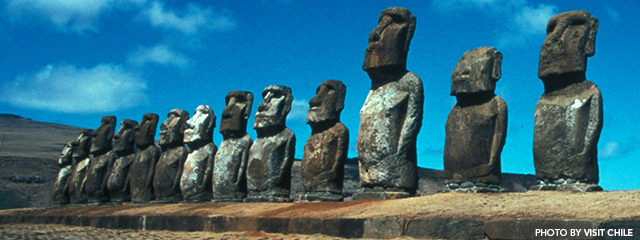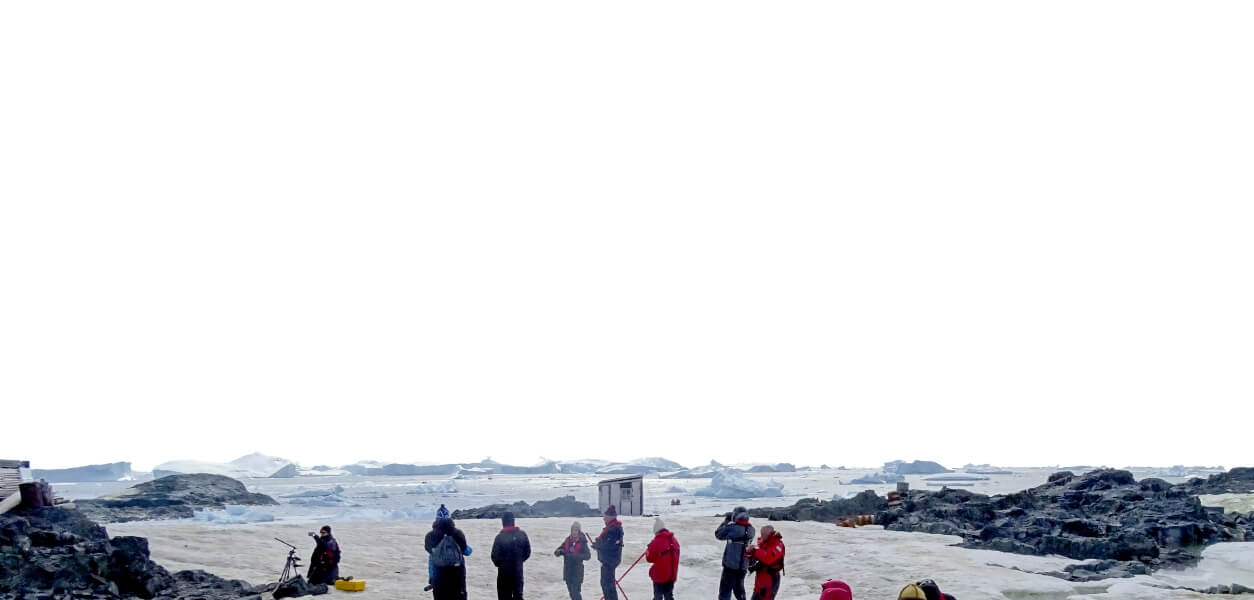 Easter Island is one of the world's most isolated inhabited islands, lying approximately 2,180 miles away from the Chilean coast. As such, the native people who first lived on the island, known as the Rapa Nui, were basically in their own world and depended solely on the resources the land had to offer. After hundreds of years of exploiting the environment, however, they brought upon themselves their own demise; a scenario that many scientists fear is representative of our own future as a planet.
To give a better understanding, allow me to elucidate on Easter island's history. Around 1200 A.D., a small group of Polynesians moved into the island and soon began populating it. When they arrived, the island, though small in size, was covered by trees. The rich soil lent itself to good farming, and the inhabitants began using the slash-and-burn method of agriculture. As they cut more and more trees down to make space for thousands of people and expand the farmlands, they inadvertently were over-exploiting their resources. After just a few generations, the inverse proportions were catastrophic: there were too many people and no trees at all.
As a result, the once dynamic Rapa Nui people were reduced to living marginal lives with less than meager tools and canoes. When Captain James Cook arrived at the island on Easter of 1774, for which the territory was named after, he counted only about 700 natives, a dramatic decrease from previous populations.
It is quite astounding that a civilization capable of building and erecting statues as large and detailed as the famous moai around the island could be depleted through such devastation. But there is a valuable lesson to be learned of Easter Island's rise and fall. While we are presently achieving stellar developments in many fields thanks to technology, it is quite possible that we too turn a blind eye to the ever decreasing supply of natural resources, and eventually meet our own collapse.
Keep in mind, such claims made by writers and scientists are often disputed, but it is a metaphor that we as humans should heed. It is very important to conserve the environment and the different animal species around the world. While humanity can grow and learn from precedent civilizations, it is vital to remember how essential it is to preserve all natural resources, as they are the basic root for life.
Easter Island is one of the world's most isolated inhabited islands, lying approximately 2,180 miles away from the Chilean coast. As such, the native people who first lived on the island, known as the Rapa Nui, were basically in their own world and depended solely on the resources the land had to offer. After hundreds of years of exploiting the environment, however, they brought upon themselves their own demise; a scenario that many scientists fear is representative of our own future as a planet.
To give a better understanding, allow me to elucidate on Easter island's history. Around 1200 A.D., a small group of Polynesians moved into the island and soon began populating it. When they arrived, the island, though small in size, was covered by trees. The rich soil lent itself to good farming, and the inhabitants began using the slash-and-burn method of agriculture. As they cut more and more trees down to make space for thousands of people and expand the farmlands, they inadvertently were over-exploiting their resources. After just a few generations, the inverse proportions were catastrophic: there were too many people and no trees at all.
As a result, the once dynamic Rapa Nui people were reduced to living marginal lives with less than meager tools and canoes. When Captain James Cook arrived at the island on Easter of 1774, for which the territory was named after, he counted only about 700 natives, a dramatic decrease from previous populations.
It is quite astounding that a civilization capable of building and erecting statues as large and detailed as the famous moai around the island could be depleted through such devastation. But there is a valuable lesson to be learned of Easter Island's rise and fall. While we are presently achieving stellar developments in many fields thanks to technology, it is quite possible that we too turn a blind eye to the ever decreasing supply of natural resources, and eventually meet our own collapse.
Keep in mind, such claims made by writers and scientists are often disputed, but it is a metaphor that we as humans should heed. It is very important to conserve the environment and the different animal species around the world. While humanity can grow and learn from precedent civilizations, it is vital to remember how essential it is to preserve all natural resources, as they are the basic root for life. Easter Island is one of the world's most isolated inhabited islands, lying approximately 2,180 miles away from the Chilean coast. As such, the native people who first lived on the island, known as the Rapa Nui, were basically in their own world and depended solely on the resources the land had to offer. After hundreds of years of exploiting the environment, however, they brought upon themselves their own demise; a scenario that many scientists fear is representative of our own future as a planet.
To give a better understanding, allow me to elucidate on Easter island's history. Around 1200 A.D., a small group of Polynesians moved into the island and soon began populating it. When they arrived, the island, though small in size, was covered by trees. The rich soil lent itself to good farming, and the inhabitants began using the slash-and-burn method of agriculture. As they cut more and more trees down to make space for thousands of people and expand the farmlands, they inadvertently were over-exploiting their resources. After just a few generations, the inverse proportions were catastrophic: there were too many people and no trees at all.
As a result, the once dynamic Rapa Nui people were reduced to living marginal lives with less than meager tools and canoes. When Captain James Cook arrived at the island on Easter of 1774, for which the territory was named after, he counted only about 700 natives, a dramatic decrease from previous populations.
It is quite astounding that a civilization capable of building and erecting statues as large and detailed as the famous moai around the island could be depleted through such devastation. But there is a valuable lesson to be learned of Easter Island's rise and fall. While we are presently achieving stellar developments in many fields thanks to technology, it is quite possible that we too turn a blind eye to the ever decreasing supply of natural resources, and eventually meet our own collapse.
Keep in mind, such claims made by writers and scientists are often disputed, but it is a metaphor that we as humans should heed. It is very important to conserve the environment and the different animal species around the world. While humanity can grow and learn from precedent civilizations, it is vital to remember how essential it is to preserve all natural resources, as they are the basic root for life.
Easter Island is one of the world's most isolated inhabited islands, lying approximately 2,180 miles away from the Chilean coast. As such, the native people who first lived on the island, known as the Rapa Nui, were basically in their own world and depended solely on the resources the land had to offer. After hundreds of years of exploiting the environment, however, they brought upon themselves their own demise; a scenario that many scientists fear is representative of our own future as a planet.
To give a better understanding, allow me to elucidate on Easter island's history. Around 1200 A.D., a small group of Polynesians moved into the island and soon began populating it. When they arrived, the island, though small in size, was covered by trees. The rich soil lent itself to good farming, and the inhabitants began using the slash-and-burn method of agriculture. As they cut more and more trees down to make space for thousands of people and expand the farmlands, they inadvertently were over-exploiting their resources. After just a few generations, the inverse proportions were catastrophic: there were too many people and no trees at all.
As a result, the once dynamic Rapa Nui people were reduced to living marginal lives with less than meager tools and canoes. When Captain James Cook arrived at the island on Easter of 1774, for which the territory was named after, he counted only about 700 natives, a dramatic decrease from previous populations.
It is quite astounding that a civilization capable of building and erecting statues as large and detailed as the famous moai around the island could be depleted through such devastation. But there is a valuable lesson to be learned of Easter Island's rise and fall. While we are presently achieving stellar developments in many fields thanks to technology, it is quite possible that we too turn a blind eye to the ever decreasing supply of natural resources, and eventually meet our own collapse.
Keep in mind, such claims made by writers and scientists are often disputed, but it is a metaphor that we as humans should heed. It is very important to conserve the environment and the different animal species around the world. While humanity can grow and learn from precedent civilizations, it is vital to remember how essential it is to preserve all natural resources, as they are the basic root for life.Up Next...
Learning, Connecting, and Birdwatching at the Belize Birding Festival
Guest post by Holbrook Ambassador Debbie JordanEarlier this month, I was honored to represent Holbrook as the keynote speaker at the fifth annual Belize Birding Festival. Way down in the southeast co
Photo of the Month: November 2025
Above: On the way to see baobab trees at sunset on the red dirt roads in the bush of Madagascar, we stopped as the young goat herders crossed directly in front of us, looking like majestic figures in the sunlit, dusty glow. It felt like the scene of a movie, and this photo captured the feeling of that moment perfectly.
eBird Trip Reports: South Africa
Want to know which species other Holbrook travelers have seen on their birding trips to South Africa? Check out these eBird trip reports shared by past groups to see their checklists and get an idea of what you might encounter on your own birding expedition.












